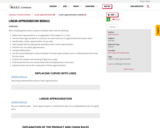
227 Results


After completing this section, students should be able to do the following.Define accumulation functions.Calculate and evaluate accumulation functions.State the First Fundamental Theorem of Calculus.Take derivatives of accumulation functions using the First Fundamental Theorem of Calculus.Use accumulation functions to find information about the original function.Understand the relationship between the function and the derivative of its accumulation function.


After completing this section, students should be able to do the following.Use the first derivative to determine whether a function is increasing or decreasing.Define higher order derivatives.Compare differing notations for higher order derivatives.Identify the relationships between the function and its first and second derivatives.Sketch a graph of the second derivative, given the original function.Sketch a graph of the original function, given the graph of its first or second derivative.Sketch a graph of a function satisfying certain constraints on its higher-order derivatives.State the relationship between concavity and the second derivative.Interpret the second derivative of a position function as acceleration.Calculate higher order derivatives.Given the graph of a position function, find time intervals where the velocity is positive/negativeGiven the graph of a position function, find time intervals where the velocity is increasing/decreasing


After completing this section, students should be able to do the following.Implicitly differentiate expression.Find the equation of the tangent line for curves that are not plots of functions.Understand how changing the variable changes how we take the derivative.Understand the derivatives of functions that are not defined explicitly in terms of an independent variable .Explain the formula for the derivative of the natural log function.Calculate derivatives of logs in any base.Calculate the derivative of an exponential function, axax, where a>0a>0.


After completing this section, students should be able to do the following.Understand what is meant by the form of a limit.Calculate limits of the form zero over zero.Calculate limits of the form nonzero number over zero.Identify determinate and indeterminate forms.Distinguish between determinate and indeterminate forms.Discuss why infinity is not a number.




After completing this section, students should be able to do the following.Recall how to find limits for forms that are determinate.Define an indeterminate form.Determine if a form is indeterminate.Convert some indeterminate forms to the form zero over zero or infinity over infinity.Determine when can l’Hôpital’s Rule be used.Use l’Hôpital’s Rule to find limits.


After completing this section, students should be able to do the following.Calculate limits using the limit laws.Calculate limits by replacing a function with a continuous function that has the same limit.Understand the Squeeze Theorem and how it can be used to find limit values.Calculate limits using the Squeeze Theorem.


After completing this section, students should be able to do the following.Define linear approximation as an application of the tangent to a curve.Find the linear approximation to a function at a point and use it to approximate the function value.Identify when a linear approximation can be used.Label a graph with the appropriate quantities used in linear approximation.Find the error of a linear approximation.Compute differentials.Use the second derivative to discuss whether the linear approximation over or underestimates the actual function value.Contrast the notation and meaning of dydy versus ΔyΔy.Understand that the error shrinks faster than the displacement in the input.Justify the chain rule via the composition of linear approximations.


After completing this section, students should be able to do the following.Identify situations where logs can be used to help find derivatives.Use logarithmic differentiation to simplify taking derivatives.Take derivatives of functions raised to functions.Recognize the difference between a variable in the base and a variable in the exponent.


After completing this section, students should be able to do the following.Define a critical point.Find critical points.Define local maximum and local minimum.Classify critical points.State the First Derivative Test.Apply the First Derivative Test.Define inflection points.Find inflection points.State the Second Derivative Test.Apply the Second Derivative Test.